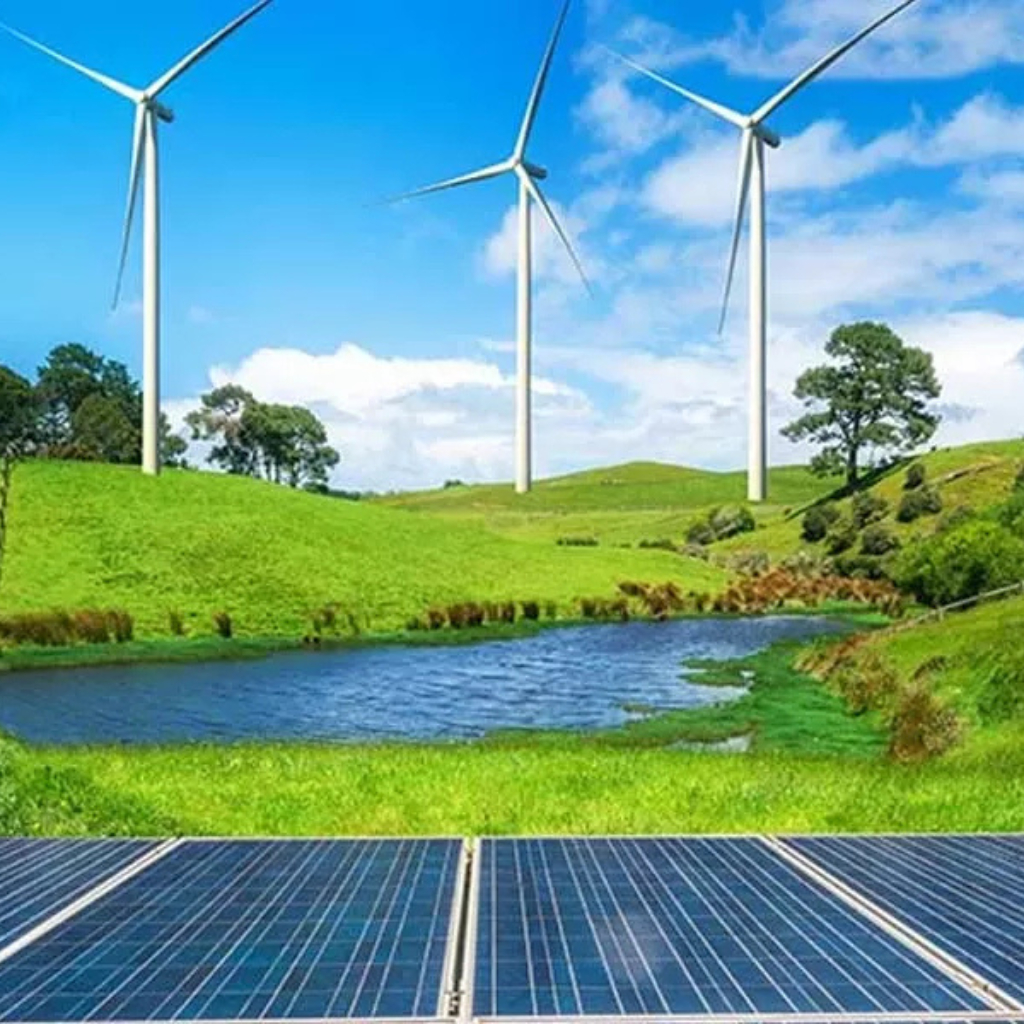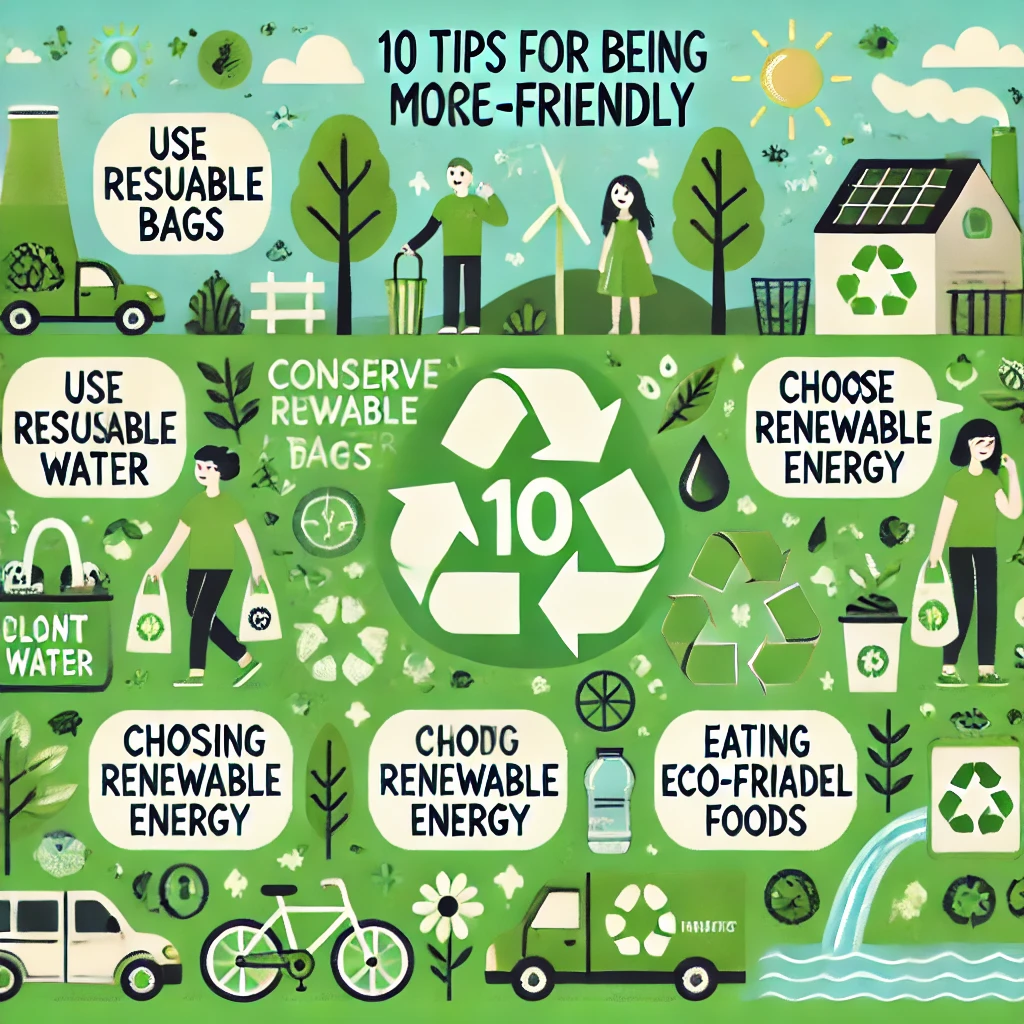Green energy, often referred to as renewable energy, encompasses energy derived from natural sources that are replenished naturally and sustainably. This includes solar energy, wind energy, hydropower, geothermal energy, and biomass. These energy sources are crucial for reducing the environmental impact caused by fossil fuels, which are responsible for pollution, greenhouse gas emissions, and climate change. As the world shifts toward more sustainable energy systems, green energy plays a vital role in addressing these global challenges by offering cleaner alternatives.
Among these renewable sources, solar and wind energy have become the most widely recognized. Solar energy harnesses the sun’s power through solar panels, converting sunlight into electricity, while wind energy relies on turbines to capture the power of moving air. Both of these energy sources are abundant, clean, and increasingly affordable, making them essential in the transition to a more sustainable future.
However, while green energy sources offer many benefits, they come with inherent challenges. One of the main hurdles is the intermittent nature of solar and wind energy. Solar power depends on sunlight, and wind power relies on the availability of wind. This means energy production from these sources can be inconsistent, varying depending on the time of day, season, or weather conditions. At times, these renewable sources generate more energy than is needed, while at other times, they produce less. This creates a mismatch between supply and demand, posing a challenge to maintaining a stable energy grid.
This is where storage solutions come into play. Energy storage technology is the key to overcoming the intermittent nature of renewable energy. By storing excess energy generated during times of high production, we can ensure that there is a reliable supply of electricity available when production slows down or demand increases. Storage helps to balance the grid, prevent blackouts, and ensure that renewable energy is used as efficiently as possible. Whether it’s through batteries, pumped hydro storage, or other technologies, the role of storage in green energy systems is indispensable for creating a more reliable, flexible, and sustainable energy infrastructure.
Understanding Storage Space in the Context of Green Energy
Storage space in the context of green energy refers to the capacity to store excess energy generated by renewable sources, such as solar and wind, for later use. This storage is essential for balancing supply and demand, ensuring that electricity is available when it’s needed, even when renewable energy production is not at its peak. Storage solutions are critical to the smooth operation of a renewable energy grid, helping to optimize energy usage and reduce reliance on traditional fossil fuel-based power sources.
There are several types of storage systems used in green energy, each with its unique technology, benefits, and applications. These systems can be broadly categorized into two main types: electrical energy storage and mechanical energy storage. Let’s explore some of the most common storage technologies used in green energy systems.
1. Batteries
Batteries are one of the most widely recognized and rapidly evolving forms of energy storage. They store energy in the form of chemical potential and release it as electricity when needed. The most common types of batteries used for energy storage are lithium-ion batteries, lead-acid batteries, and emerging technologies like solid-state batteries.
- Lithium-ion batteries are the most popular due to their efficiency, long life span, and scalability. They are used in everything from small-scale home energy storage systems to large utility-scale storage projects.
- Lead-acid batteries are less expensive but have a shorter lifespan and lower efficiency than lithium-ion options.
- Solid-state batteries are still in the research and development phase, but they promise to offer higher energy densities, faster charging times, and greater safety.
Batteries are ideal for short- to medium-term energy storage and are increasingly used in home energy systems, electric vehicles, and grid storage applications.
2. Pumped Hydro Storage
Pumped hydro storage is one of the oldest and most widely used methods of large-scale energy storage. It works by using electricity to pump water from a lower reservoir to a higher elevation when excess energy is available. When demand for electricity rises, the stored water is released back down to the lower reservoir, passing through turbines that generate electricity.
This system is highly efficient and can store large amounts of energy for long periods. It is often used for grid balancing, particularly in areas with suitable geographical features, such as large mountains or rivers.
3. Compressed Air Energy Storage (CAES)
Compressed Air Energy Storage (CAES) is another method of storing energy, although it is less common than pumped hydro. In a CAES system, excess electricity is used to compress air and store it in underground caverns or tanks. When electricity is needed, the compressed air is released, passed through turbines, and used to generate power.
CAES systems can store large amounts of energy and have the potential for long-duration storage, making them valuable for grid-scale applications. However, they are limited by the availability of suitable underground storage sites and are generally less efficient than pumped hydro.
4. Flywheel Energy Storage
Flywheel energy storage systems store energy in the form of rotational kinetic energy. The system uses electricity to spin a rotor (flywheel) at very high speeds. When energy is needed, the flywheel slows down, and the energy released is converted back into electricity. Flywheel systems are known for their quick response times and ability to handle short bursts of energy demand, making them ideal for stabilizing the grid during rapid fluctuations in energy supply and demand.
Flywheels are commonly used in applications where fast energy discharge is required, such as frequency regulation in grid management, but they are not typically used for long-term storage due to limited energy capacity.
5. Thermal Energy Storage
Thermal energy storage systems store excess energy in the form of heat. This energy can later be converted back into electricity or used directly for heating purposes. In some systems, excess electricity is used to heat a medium (such as molten salt or water), which retains the heat for hours or even days. This stored thermal energy can then be used to generate electricity or provide heat to buildings and industrial processes.
Thermal storage is particularly useful for concentrating solar power (CSP) plants, where sunlight is concentrated to heat a fluid that is stored for later use in electricity generation.
The Importance of Storage Space in Green Energy Systems
Each of these storage technologies plays a unique role in the larger green energy ecosystem. Batteries are essential for short-term and residential applications, pumped hydro is a proven solution for large-scale grid storage, and CAES and flywheels offer viable options for balancing energy supply and demand over medium-term periods. Thermal storage, on the other hand, has a crucial role in integrating solar power into the grid.
How Storage Space Supports Renewable Energy Integration
One of the greatest challenges of integrating renewable energy sources like solar and wind into the broader energy grid is their intermittent nature. Solar energy is only generated when the sun shines, and wind energy is only available when the wind blows. This inconsistency can create imbalances between energy production and consumption. The role of storage space is essential in overcoming this challenge, as it allows for the efficient use of renewable energy by storing excess energy produced during peak production periods and releasing it when needed.
Storing Energy During Peak Production
Renewable energy systems often generate more electricity than is needed during periods of peak production. For example, solar panels produce their maximum output during the midday hours when the sun is at its highest. Similarly, wind farms tend to generate more power when winds are strong, which can be at night or during certain seasons. However, energy demand does not always align with these peak production periods, as consumers typically use more electricity in the evenings or during cold weather when the sun may not be shining or the wind may have calmed.
Storage solutions can capture this excess energy during these times of high production and store it for later use. For instance, battery storage systems can absorb the surplus electricity generated by solar panels or wind turbines and store it in batteries. This stored energy can then be discharged when demand rises, ensuring a reliable and continuous power supply. By storing energy when production exceeds demand, storage systems prevent the wastage of renewable energy that might otherwise go unused.
Managing Fluctuations in Energy Supply and Demand
The ability to store energy is also crucial for balancing fluctuations in both energy supply and demand. The supply of renewable energy is not constant; it varies based on environmental factors like weather, time of day, and season. For example, on cloudy days, solar panels generate less electricity, and on windless days, wind turbines produce little to no power. These fluctuations create challenges in meeting electricity demand, especially during peak usage periods such as hot summer afternoons or winter evenings.
Energy storage technologies help smooth out these fluctuations. By storing energy when there is an oversupply (such as during sunny or windy days), storage systems can release this energy during periods of low renewable generation (such as during the night or calm weather). This ability to manage supply and demand ensures a stable energy grid, preventing power shortages or blackouts and reducing the need for fossil fuel backup generation.
Moreover, large-scale storage systems, such as pumped hydro storage or compressed air energy storage (CAES), can play a significant role in balancing long-term fluctuations. These systems can store energy over extended periods, such as days or weeks, which is particularly useful for dealing with seasonal variations. For example, excess solar energy generated in the summer can be stored for use during the winter months when solar production is lower.
Storage also helps to improve the overall reliability and flexibility of the energy grid. By stabilizing fluctuations, storage allows for better integration of renewable sources into the grid, making it less dependent on traditional, polluting energy sources like coal or natural gas. This not only helps reduce carbon emissions but also supports a more sustainable and resilient energy system.
Enabling Grid Resilience and Flexibility
In addition to smoothing out short-term supply and demand imbalances, storage solutions contribute to grid resilience by acting as a buffer in the event of unexpected disruptions. For example, during extreme weather events or unforeseen drops in renewable energy production, stored energy can be quickly dispatched to fill in the gap, ensuring the grid remains stable and power outages are minimized. This ability to respond rapidly to fluctuations strengthens the overall robustness of the energy infrastructure, especially as more variable renewable sources are integrated into the grid.
Energy Storage Solutions for a Sustainable Future
As the world moves towards a more sustainable, low-carbon future, energy storage plays a pivotal role in ensuring that renewable energy sources like solar and wind can be efficiently integrated into our power systems. The combination of large-scale and decentralized storage solutions forms the backbone of a sustainable energy infrastructure, providing both the flexibility and reliability needed to make renewable energy the primary source of power.
Role of Large-Scale Energy Storage (Grid Storage)
Large-scale energy storage systems are designed to store vast amounts of energy for the entire grid, helping to manage fluctuations in renewable energy generation and ensuring a continuous, reliable power supply. These systems are often deployed in utility-scale applications and can store energy for long periods, releasing it when demand peaks or renewable generation is low.
- Pumped Hydro Storage: The most well-established large-scale storage solution, pumped hydro storage works by using excess energy to pump water from a lower reservoir to a higher one. When energy demand increases or renewable energy supply drops, the stored water is released, generating electricity as it flows down to the lower reservoir. Pumped hydro systems are capable of storing large quantities of energy for extended periods and are highly efficient, making them ideal for grid balancing.
- Compressed Air Energy Storage (CAES): In CAES, excess energy is used to compress air and store it in underground caverns or tanks. This air is released and expanded through turbines to generate power when needed. CAES systems can provide energy storage over a longer duration and are particularly useful for balancing the grid during seasonal fluctuations, though they require specific geological conditions.
- Flow Batteries and Advanced Technologies: Flow batteries are another promising technology for large-scale energy storage. Unlike conventional batteries, flow batteries store energy in external tanks filled with liquid electrolytes, making them scalable for grid storage applications. These systems are still in the development phase but hold potential for long-duration energy storage and can be charged and discharged many times without losing efficiency.
Large-scale energy storage systems like these enable grid operators to store excess renewable energy during times of low demand and release it when needed, allowing for more efficient use of renewable sources. They help prevent curtailment, which occurs when renewable energy generation exceeds grid capacity, and reduce the need for fossil fuel-based backup generation. By providing grid stability and flexibility, these large-scale storage solutions support the broader transition to a sustainable energy system.
Benefits of Decentralized Storage (Home Batteries, Electric Vehicles)
In addition to large-scale storage systems, decentralized energy storage solutions have become increasingly important in creating a sustainable energy future. These smaller-scale systems are typically installed at the point of energy generation or consumption, such as homes, businesses, or electric vehicles (EVs). They offer unique advantages for both individual users and the broader grid.
- Home Batteries: Home battery systems, such as the popular Tesla Powerwall or LG Chem Resu, allow homeowners with solar panels to store excess energy generated during the day for use at night or during power outages. This reduces reliance on the grid and lowers electricity bills, while providing greater energy independence. Home batteries also offer a way for consumers to participate in demand response programs, where they can provide stored energy back to the grid during peak demand periods, earning compensation and helping stabilize the grid.
- Electric Vehicles (EVs): EVs can also serve as a form of decentralized energy storage. Many electric vehicles have large battery capacities, and vehicle-to-grid (V2G) technology is emerging, allowing EVs to return stored energy to the grid when needed. This creates a two-way flow of electricity, where EV owners can charge their vehicles during off-peak hours when electricity is cheaper and return that energy during peak demand periods, helping to stabilize the grid. In this way, EVs function as mobile energy storage units, contributing to grid resilience and promoting a cleaner, more flexible energy system.
- Microgrids and Localized Energy Systems: Decentralized storage can be a key element of microgrids, which are small, localized energy systems that can operate independently or in conjunction with the main grid. Microgrids can integrate renewable energy sources, energy storage, and load management, enabling communities to generate, store, and distribute their own energy. In the event of a grid outage, microgrids can provide energy security and help reduce the strain on the larger grid, enhancing overall system resilience.
Decentralized storage offers numerous benefits for consumers and the energy grid alike. By reducing demand on the central grid, it helps lower energy costs, enhance energy security, and increase the adoption of renewable energy. Furthermore, when combined with renewable generation systems like solar and wind, decentralized storage contributes to a more sustainable and efficient energy infrastructure.
Reducing Carbon Footprint with Efficient Storage Solutions
One of the primary objectives of the green energy movement is to reduce carbon emissions and our reliance on fossil fuels, which contribute to climate change and environmental degradation. Efficient energy storage solutions are instrumental in this goal, playing a critical role in enhancing the adoption and integration of renewable energy sources into our power systems.
Impact on Reducing Reliance on Fossil Fuels
Renewable energy sources like solar, wind, and hydropower produce little to no carbon emissions during operation. However, their intermittent nature—solar power generation only occurring during daylight and wind power varying with weather conditions—often necessitates backup power systems, which have traditionally relied on fossil fuels such as coal, natural gas, or oil. Energy storage helps reduce this dependency by enabling the capture and storage of excess renewable energy when available, which can then be used when renewable generation is low.
For example, solar energy captured during the day can be stored in batteries or other storage systems and used in the evening when the sun sets. Similarly, wind energy produced at night can be stored and released during peak demand times. By storing clean energy and minimizing the need for fossil fuel-based backup generation, storage solutions significantly reduce the carbon footprint of energy systems.
Furthermore, by enabling greater grid flexibility, storage technologies support the increased penetration of renewables into the energy mix, making it easier for utilities and businesses to reduce their reliance on fossil-fuel-powered plants and transition to a cleaner energy future.
Storage Technologies as a Key Enabler of Green Energy Transition
Efficient energy storage solutions serve as the backbone of the green energy transition by enabling the practical and widespread use of renewable energy sources. Storage systems like batteries, pumped hydro, and compressed air storage provide the flexibility needed to balance the variability of renewable energy production with the demands of consumers. Without efficient storage solutions, the large-scale integration of renewable sources would be challenging, as energy production could not be consistently matched to demand.
By improving grid stability and enabling power to be stored for later use, these technologies allow for a reliable and continuous flow of clean energy, significantly reducing the need for fossil fuels. This not only helps reduce carbon emissions but also supports the decarbonization of entire industries, such as transportation and manufacturing, that rely on fossil fuels.
Advances in Energy Storage Technology
The field of energy storage has seen tremendous growth in recent years, with new breakthroughs in battery storage and innovations in other methods that are enhancing the efficiency, cost-effectiveness, and scalability of storage solutions.
Breakthroughs in Battery Storage
- Lithium-Ion Batteries: Currently, lithium-ion batteries are the most widely used energy storage solution due to their high energy density, efficiency, and relatively low cost. They are commonly used in residential energy storage systems, electric vehicles, and grid applications. Lithium-ion batteries are also rapidly evolving, with improvements in lifespan, safety, and charge/discharge speeds.
- Solid-State Batteries: Solid-state batteries represent a major advancement in energy storage technology. Unlike traditional lithium-ion batteries, which use liquid electrolytes, solid-state batteries use solid electrolytes, offering several key advantages, including greater energy density, faster charging times, and enhanced safety. These batteries have the potential to revolutionize the energy storage market, making them a promising solution for large-scale applications, electric vehicles, and consumer electronics.
Innovations in Other Storage Methods
- Flywheels: Flywheel storage systems store energy mechanically by spinning a rotor at high speeds. When energy is needed, the spinning rotor’s kinetic energy is converted back into electricity. Flywheels offer fast response times and long lifespans with minimal maintenance, making them an excellent choice for grid stabilization and balancing short-term energy fluctuations.
- Pumped Hydro Storage: Though already widely used, pumped hydro storage is seeing advancements that improve its efficiency and adaptability. New techniques are being explored to expand pumped hydro systems into areas with less suitable geography, as well as to optimize their operations to increase energy storage capacities.
These advances in energy storage technologies are helping to overcome previous limitations, such as high costs, long payback periods, and storage inefficiencies. As these technologies continue to evolve, they will become more widely accessible and play an even greater role in the global shift towards renewable energy.
Challenges in Energy Storage for Green Energy
While energy storage is crucial for enabling a sustainable energy future, there are several challenges that need to be addressed to fully harness the potential of these technologies.
Cost, Scalability, and Infrastructure Challenges
One of the primary challenges of energy storage is the cost. While the price of batteries has dropped significantly over the past decade, energy storage systems are still relatively expensive to deploy, particularly for large-scale applications. This makes it difficult for many utilities and businesses to make the switch to renewable energy sources without significant upfront investments. Scalability remains an issue as well—some technologies, like pumped hydro, require specific geographical conditions, limiting their widespread use. Moreover, the infrastructure needed to integrate energy storage with existing grids often requires costly upgrades, making the transition to a more sustainable system challenging.
Environmental Impact and Resource Availability
Another challenge lies in the environmental impact of producing and disposing of energy storage systems, particularly batteries. While lithium-ion batteries are widely used, the extraction of materials like lithium, cobalt, and nickel can have significant environmental and ethical implications. Additionally, the recycling of old batteries and the disposal of used storage systems present growing environmental concerns.
The development of sustainable and recyclable storage technologies is critical to reducing these impacts. Innovations in materials science are exploring ways to create more environmentally friendly storage solutions, such as using abundant, non-toxic materials in batteries and improving recycling processes.
The Future of Energy Storage in Green Energy Systems
As energy storage technologies continue to evolve, the future of storage in green energy systems looks promising. Storage solutions will become increasingly critical in the transition to a fully renewable-powered world.
Potential for Widespread Adoption and Integration
With continued advancements, energy storage systems will become more efficient, cost-effective, and scalable, leading to their widespread adoption across industries and communities. As battery prices continue to fall and performance improves, more businesses, households, and even entire regions will be able to deploy energy storage systems to store renewable energy. This will allow for greater integration of solar, wind, and other renewable sources into the grid, reducing the need for fossil fuel-based backup power and enabling a fully green energy infrastructure.
Role of Government Policies and Investments
Governments around the world have a critical role to play in accelerating the adoption of energy storage technologies. By providing incentives, subsidies, and funding for research and development, governments can stimulate innovation and reduce the financial barriers to widespread storage adoption. Policies aimed at creating more sustainable energy markets, such as carbon pricing or renewable energy mandates, can also encourage the use of energy storage as a key tool in achieving energy goals.
Government investments in infrastructure, such as upgrading the grid to support energy storage and renewable energy integration, will further enhance the role of storage in green energy systems. With the right policies and investments, energy storage will be a central pillar of the global transition to a cleaner, more sustainable future.
Isotropic arap energy using cauchy-green invariants
Isotropic ARAP (As-Rigid-As-Possible) energy is a method used in geometry processing to find deformations that preserve the local shape of an object as much as possible while minimizing distortions. In the context of energy minimization, Cauchy-Green invariants are used to measure the strain or deformation of an object relative to a reference configuration.
To understand isotropic ARAP energy using Cauchy-Green invariants, let’s break it down:
1. Isotropic ARAP Energy:
- ARAP energy is a form of elastic energy that aims to preserve the local structure of a shape under deformation.
- In isotropic ARAP energy, the goal is to deform the mesh in such a way that angles between edges are preserved (isotropic), meaning no directional preference is given to the deformation.
- The energy is formulated to minimize distortion in a way that stretches or shrinks the mesh minimally while keeping the geometry intact.
2. Cauchy-Green Strain Tensor:
- The Cauchy-Green strain tensor is a measure of how much a material or object has deformed. It’s used in the context of large deformations to quantify strain.
- The Cauchy-Green tensor can be written in terms of the deformation gradient F\mathbf{F}F, which relates the reference and deformed configurations of a material. C=FTF\mathbf{C} = \mathbf{F}^T \mathbf{F}C=FTF where C\mathbf{C}C is the Cauchy-Green deformation tensor, and F\mathbf{F}F is the deformation gradient.
3. Using Cauchy-Green Invariants in ARAP:
- Cauchy-Green invariants are scalar quantities derived from the Cauchy-Green tensor, such as the first invariant (I1) and the second invariant (I2).
- First invariant: I1=Tr(C)I_1 = \text{Tr}(\mathbf{C})I1=Tr(C), which represents the volumetric change of the deformation.
- Second invariant: I2=12((Tr(C))2−Tr(C2))I_2 = \frac{1}{2} \left( (\text{Tr}(\mathbf{C}))^2 – \text{Tr}(\mathbf{C}^2) \right)I2=21((Tr(C))2−Tr(C2)), which is related to the shape change.
- Isotropic ARAP energy minimizes these invariants to ensure that the deformation is as rigid as possible. Specifically, isotropic ARAP tends to minimize the changes in shape and volume, trying to maintain the original distances and angles as much as possible, even under a large deformation.
4. Energy Formulation:
The ARAP energy in terms of the Cauchy-Green invariants is often written as:
EARAP(X)=∑(i,j)∈Ewij(I1(Fij)−1)2+λ(I2(Fij)−1)2E_{\text{ARAP}}(\mathbf{X}) = \sum_{(i,j) \in \mathcal{E}} w_{ij} \left( I_1(\mathbf{F}_{ij}) – 1 \right)^2 + \lambda \left( I_2(\mathbf{F}_{ij}) – 1 \right)^2EARAP(X)=(i,j)∈E∑wij(I1(Fij)−1)2+λ(I2(Fij)−1)2
where wijw_{ij}wij are weights (such as edge lengths), and Fij\mathbf{F}_{ij}Fij is the deformation gradient between two vertices iii and jjj. λ\lambdaλ is a weighting factor that controls the balance between the invariants.
5. Applications:
- Mesh deformation: Isotropic ARAP energy is useful in mesh processing for applications such as texture mapping, shape deformation, and remeshing, where we want to preserve the local geometry as much as possible.
- Simulation of soft materials: It can be applied to simulate the deformation of soft materials, ensuring that they behave in a physically plausible manner by minimizing local distortions.
Read more: How Fleet Managers Can Go Green to Save Money
Conclusion
Isotropic ARAP (As-Rigid-As-Possible) energy, when combined with Cauchy-Green invariants, provides a robust framework for managing and minimizing deformation in geometry processing tasks. By leveraging the Cauchy-Green strain tensor and its invariants, this approach allows for a highly accurate representation of local shape preservation, ensuring that objects undergo minimal distortion during transformations. Whether applied to mesh deformation, texture mapping, or simulating soft materials, the isotropic ARAP energy formulation ensures that both shape and volume are preserved to the greatest extent possible, even in the face of complex deformations.
The use of Cauchy-Green invariants provides a mathematically rigorous way to control these deformations by directly measuring the strain in the object, thus giving practitioners a powerful tool for applications in computer graphics, finite element analysis, and other fields requiring geometric integrity. As this method continues to evolve, it will likely play a crucial role in advancing the realism and efficiency of simulations and digital models in various industries.


















